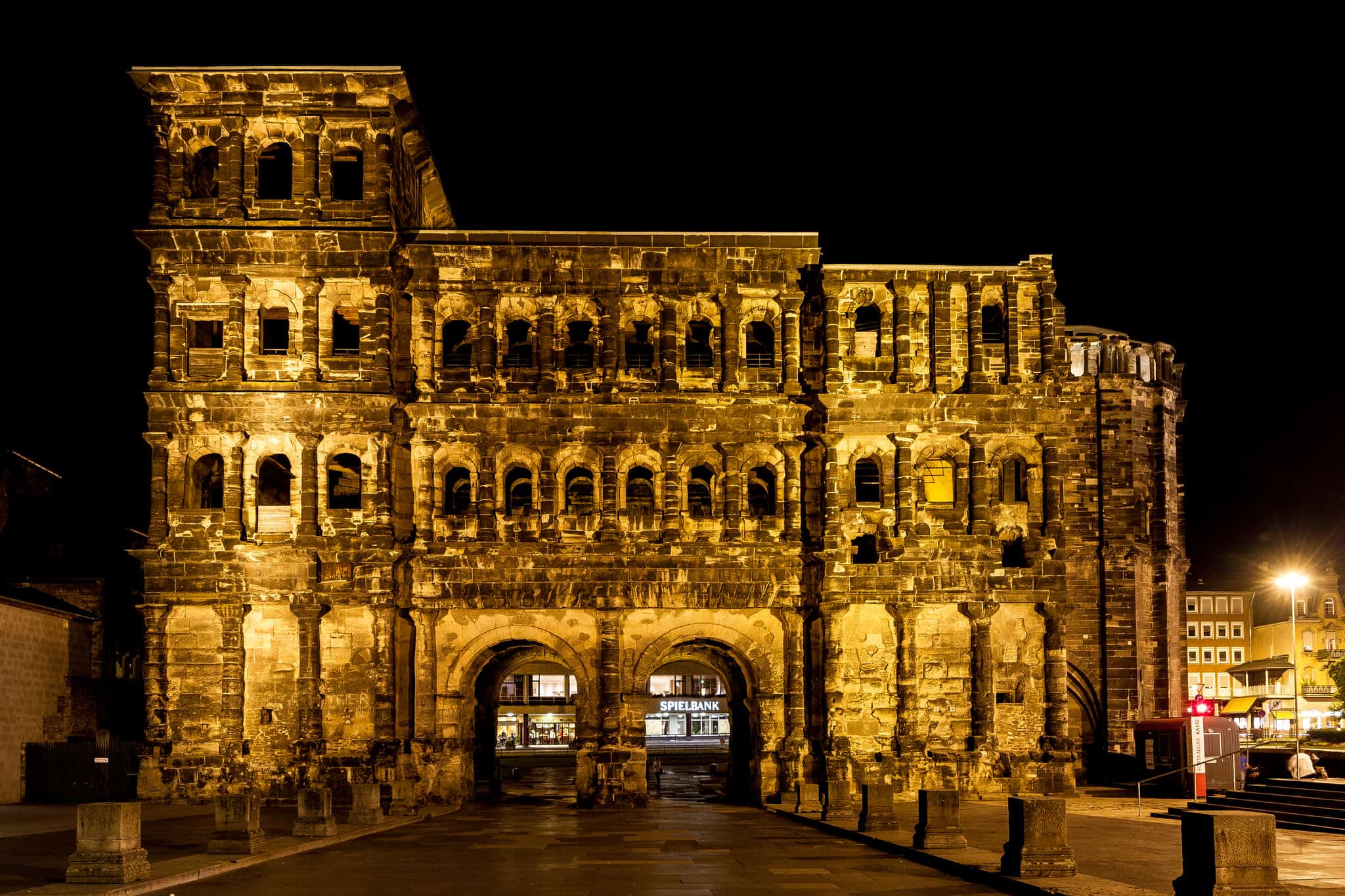Germany is definitely not one of the first countries to spring to mind when it comes to ancient Rome. Many still believe that the sprawling Roman Empire never touched much of Germany, but the territory west of the Rhine was very much part of the Roman Empire and one of its most important territories. From the biggest surviving single room of Ancient Rome to working bridges and intact burial chambers, the Roman ruins in Germany come in all shapes and sizes.
Porta Nigra
 https://www.flickr.com/photos/ni-c/
https://www.flickr.com/photos/ni-c/
Porta Nigra, or the "Black Gate," is one of the most famous Roman ruins in Germany. Built in the late 2nd century, this Roman gate is the sole remnant of imposing fortifications that once circled Germany's most Roman city of Trier, which was then known as Augusta Treverorum. The Black Gate managed to escape destruction from new developments in the city over time by being incorporated into a medieval church called Simeonstift built in honour of a sanctified Greek monk that lived as a hermit near the Porta Nigra. Although the church that protected Porta Nigra was dissolved by Napoleon in 1802, both survived not only his reign in the area but both World Wars to become a protected UNESCO World Heritage site in 1986.
Today, visitors can tour the blackened stone gate as well as the 100 meters of original Roman columns leading up to it. Due to the pollution of passing cars damaging the stones of both the Black Gate and its attached church, car traffic has been banned in the nearby area, although both still remain in remarkable condition.
The Basilica of Constantine
 https://www.flickr.com/photos/archer10/
https://www.flickr.com/photos/archer10/
The Basilica of Constantine is another one of Trier's prominent Ancient Roman structures. The Basilica was the place where Emperor Constantine the Great would meet with audiences while in the city that was, at the time of the Basilica's construction, the capital of Rome's Western Empire. Unfortunately, what visitors see when visiting the Basilica of Constantine today is not what originally was, it is only a mere shadow of it. In the fifth century, invading Germanic tribes saw the Basilica destroyed, but in the 17th century, city officials saw it restored, albeit partially incorporated with a nearby palace that served as army barracks at the time.
After the end of World War II, the Basilica was renovated once again to repair injuries to the building. It was then decided to restore it as close to its Roman design as they could. Today, it is now used as a church and stands as one of the largest single Ancient Roman rooms in existence that remains intact, although the windows make it appear bigger than it actually is.
Romerbrucke
 https://www.flickr.com/photos/station_nord/
https://www.flickr.com/photos/station_nord/
Rome built and burned a lot of bridges during it's time, both physical and metaphorical. Roman bridges are some of their most important architectural achievements that used to connect their empire of roads and allowed their massive army to move more quickly. Unfortunately, not many Roman bridges have survived the trials of history. It seems many found preserving some of its more stunning architectural achievements more important than a lowly bridge that helped connect an empire. Romerbrucke is one of the few intact Roman bridges still in existence and actively used today. Romerbrucke connects the banks of the Mosel River outside of Trier and has connected them since it was built in 152 AD, making it the oldest bridge in the country.
Weiden Roman Burial Chamber
Located on the outskirts of Cologne, the Weiden Roman Burial Chamber is one of the lesser known, but still significant, Roman ruins in Germany. The tomb was originally the called the Colonia Claudia Ara Agrippinensium, in reference to who was buried there. Agrippina was the daughter of Germanicus and the wife of Emperor Claudius. She was born in Cologne and was returned to the area in this tomb upon her death. While her body is long decomposed and whisked off to study at the Romano-Germanic Museum kilometers away in the Cologne city limits, visitors who head to the Weiden Roman Burial Chamber can view the pottery, murals and a series of sculptures that sit in a tomb befitting the wife of an emperor.
Imperial Baths of Trier
 https://www.flickr.com/photos/infidelic/
https://www.flickr.com/photos/infidelic/
The Imperial Baths of Trier are a beautifully preserved Roman public bath complex constructed in the fourth century AD. These bathes are widely considered to be the largest public baths built outside of Rome itself.
Centrally located within this city, visitors can explore this absolutely stunning Roman site that is complete with its original walls and visitors are even afforded the option to explore the labyrinth of underground tunnels built underneath the site which were used to help heat them.
These imperial baths mark the highlight of a series of mass developments within Trier that show just how important and flourishing the city was during it's time with the Roman Empire.


